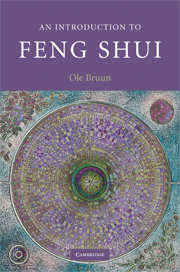Book contents
- Frontmatter
- Contents
- List of illustrations
- 1 Introduction
- 2 A brief history of feng shui
- 3 Feng shui in the context of Chinese popular religion
- 4 Feng shui research
- 5 Cosmological principles, schools of interpretation and the feng shui compass
- 6 Feng shui in the Chinese cityscape: China proper and overseas
- 7 Modern feng shui interpretations and uses
- 8 Environmental concerns
- 9 Feng shui as cultural globalization?
- Bibliography
- Index
2 - A brief history of feng shui
Published online by Cambridge University Press: 05 June 2012
- Frontmatter
- Contents
- List of illustrations
- 1 Introduction
- 2 A brief history of feng shui
- 3 Feng shui in the context of Chinese popular religion
- 4 Feng shui research
- 5 Cosmological principles, schools of interpretation and the feng shui compass
- 6 Feng shui in the Chinese cityscape: China proper and overseas
- 7 Modern feng shui interpretations and uses
- 8 Environmental concerns
- 9 Feng shui as cultural globalization?
- Bibliography
- Index
Summary
Forms of divination, which in theory and practice had much in common with feng shui, date back to the earliest Chinese historical records. In the early literature, however, they are referred to as zhanbu, xiangzhai, kanyu (Heaven and Earth), yin-yang and dili (earth principles/geography), while the term ‘feng shui’ only became common during the Song dynasty (960–1279). Accounting for the evolution of feng shui through the entire Chinese history would take volumes, and the subject would in any case be too difficult to sort out from general cosmology and divination. Instead, this chapter will describe the rise and significance of feng shui in relation to some crucial themes in Chinese history such as the general importance of divination, the continuous interaction between elite and popular culture and the gradual trickling down of the ways of the royal court to commoners. But first, a few points:
The further we go back in Chinese history, the less feng shui becomes separable from general cosmology such as that contained in Daoism and expressed in imperial divination.
We cannot determine whether divination of dwellings for the living or for the dead came first. In the course of Chinese history, however, divination of houses, temples, palaces and other constructions for the living became more orthodox than divination of graves for the dead.
Imperial divination, burial rituals, taking omens and symbolism linked to the Mandate of Heaven were increasingly popularized, siphoning down from the royal court and elite to the lower echelons of Chinese society. Feng shui was an important element in this process, a form of spiritual struggle with political metaphor.
[…]
- Type
- Chapter
- Information
- An Introduction to Feng Shui , pp. 11 - 48Publisher: Cambridge University PressPrint publication year: 2008



